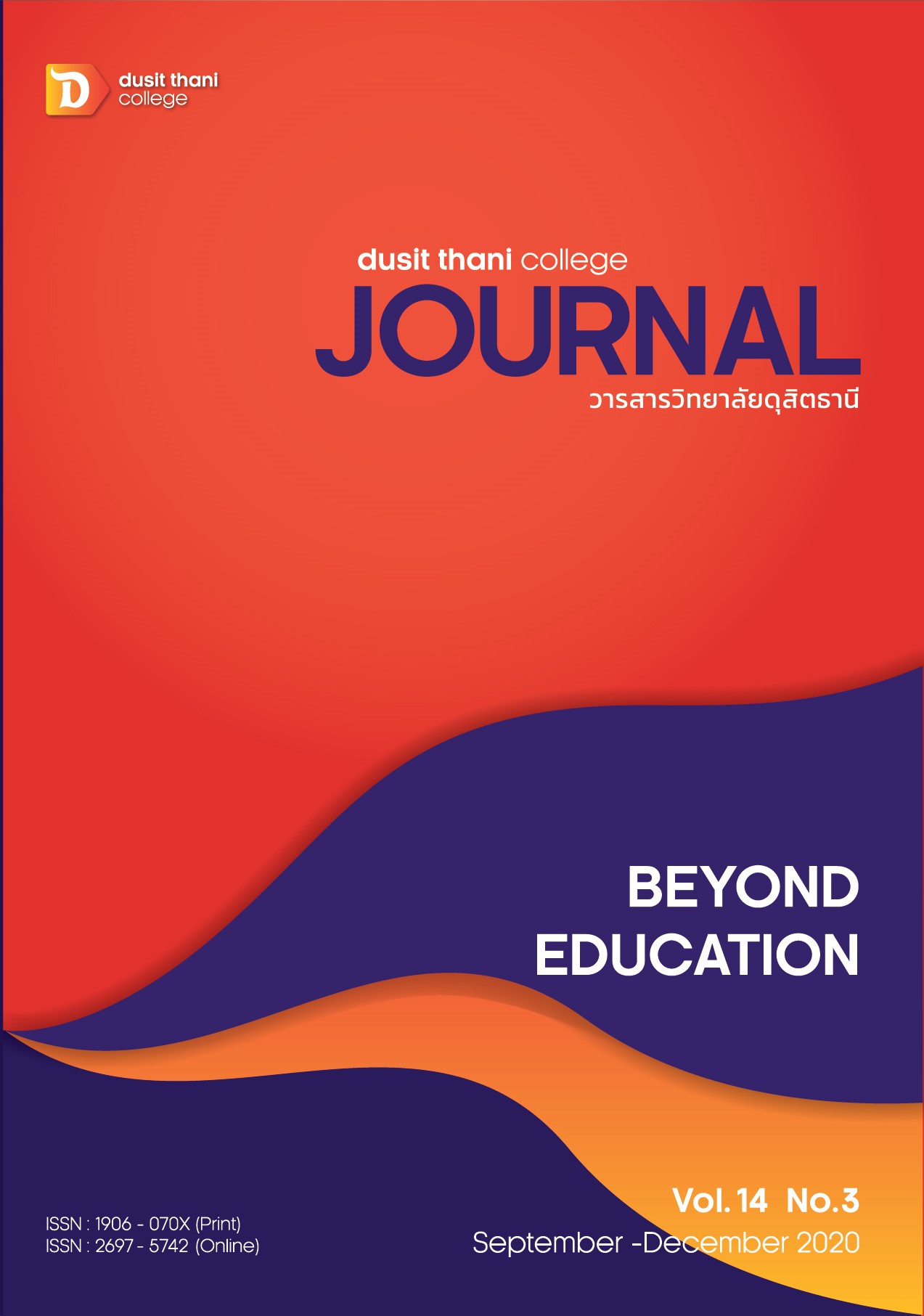การปรากฏตัวทางไกล (Telepresence) ในฐานะตัวแปรส่งผ่านจากคุณลักษณะการโพสต์เฟซบุ๊กไปสู่การบูรณาการชุมชนตราสินค้าในสื่อสังคมออนไลน์
Main Article Content
บทคัดย่อ
งานวิจัยนี้นำเสนอและพิสูจน์กรอบแนวคิดของตัวแปร การโพสต์เฟซบุ๊ก (Facebook Page Posts) ประสบการณ์การปรากฏทางไกล (Telepresence) และการบูรณาการของชุมชนตราสินค้าในสื่อสังคมออนไลน์ (Integration of Social Media Based Brand Community) โดยมีกลุ่มประชากรได้แก่ สมาชิกผู้ติดตามเฟซบุ๊กที่เป็นทางการของสโมสรฟุตบอลอาชีพแห่งหนึ่งที่ได้ติดตามรูปแบบและเนื้อหาการโพสต์อย่างน้อยเป็นเวลา 1 เดือน ผลการทดสอบโมเดลสมการโครงสร้างพบค่าดัชนีความสอดคล้อง (Fit Indices) อยู่ในเกณฑ์ที่สามารถยอมรับได้ นอกจากนี้ในการทดสอบสมมติฐานพบว่าค่าความสัมพันธ์และค่าอิทธิพลมีนัยสำคัญทางสถิติทั้งหมด งานวิจัยนี้ได้ต่อยอดองค์ความรู้ว่าการโพสต์เฟซบุ๊กที่มีคุณลักษณะการโพสต์แบบชัดเจนและแบบปฎิสัมพันธ์ไม่เพียงส่งผลต่อความนิยมในตัวโพสต์เท่านั้น แต่ยังสามารถส่งอิทธิพลต่อประสบการณ์การปรากฏตัวทางไกลและการสร้างความเข้มแข็งของชุมชนตราสินค้าสื่อสังคมออนไลน์ด้วย
Article Details
นโยบายการพิจารณากลั่นกรองบทความ
- บทความวิจัยและบทความวิชาการทุกเรื่องที่จะได้รับการตีพิมพ์ต้องผ่านการพิจารณากลั่นกรองโดยผู้ทรงคุณวุฒิ (Peer Review) ในสาขาที่เกี่ยวข้อง จำนวน 3 ท่าน/บทความ
- บทความ ข้อความ ภาพประกอบและตารางประกอบที่ลงตีพิมพ์ในวารสารเป็นความคิดเห็นส่วนตัวของผู้เขียน กองบรรณาธิการไม่จำเป็นต้องเห็นด้วยเสมอไป และไม่มีส่วนรับผิดชอบใด ๆ ถือเป็นความรับผิดชอบของผู้เขียนแต่เพียงผู้เดียว
- บทความที่จะได้รับการตีพิมพ์จะต้องไม่เคยตีพิมพ์ เผยแพร่ที่ใดมาก่อน และไม่อยู่ระหว่างการพิจารณาของวารสารฉบับอื่น หากตรวจสอบพบว่ามีการตีพิมพ์ซ้ำซ้อน ถือเป็นความรับผิดชอบของผู้เขียนแต่เพียงผู้เดียว
- บทความใดที่ผู้อ่านเห็นว่าได้มีการลอกเลียนหรือแอบอ้างโดยปราศจากการอ้างอิง หรือทำให้เข้าใจผิดว่าเป็นผลงานของผู้เขียน กรุณาแจ้งให้กองบรรณาธิการวารสารทราบจะเป็นพระคุณยิ่ง
เอกสารอ้างอิง
Bagozzi, R. P., & Yi, Y. (1988). On the evaluation of structural equation models. Journal of the academy of marketing science, 16(1), 74-94.
Beukeboom, C. J., Kerkhof, P., & de Vries, M. (2015). Does a virtual like cause actual liking? How following a brand's Facebook updates enhances brand evaluations and purchase intention. Journal of Interactive Marketing, 32, 26-36.
De Vries, L., Gensler, S., & Leeflang, P. S. (2012). Popularity of brand posts on brand fan pages: An investigation of the effects of social media marketing. Journal of interactive marketing, 26(2), 83-91.
Dillman, D. A. (2011). Mail and Internet surveys: The tailored design method--2007 Update with new Internet, visual, and mixed-mode guide. John Wiley & Sons.
Fornell, C., & Larcker, D. F. (1981). Evaluating structural equation models with unobservable variables and measurement error. Journal of marketing research, 18(1), 39-50.
Fortin, D. R., & Dholakia, R. R. (2005). Interactivity and vividness effects on social presence and involvement with a web-based advertisement. Journal of business research, 58(3), 387-396.
Fullerton, S., & Merz, G. R. (2008). The four domains of sports marketing: A conceptual framework. Sport Marketing Quarterly, 17(2).
Godey, B., Manthiou, A., Pederzoli, D., Rokka, J., Aiello, G., Donvito, R., & Singh, R. (2016).
Social media marketing efforts of luxury brands: Influence on brand equity and consumer behavior. Journal of business research, 69(12), 5833-5841.
Laroche, M., Habibi, M. R., & Richard, M. O. (2013). To be or not to be in social media: How brand loyalty is affected by social media? International Journal of Information Management, 33(1), 76-82.
Luarn, P., Lin, Y. F., & Chiu, Y. P. (2015). Influence of Facebook brand-page posts on online engagement. Online Information Review, 39(4), 505-519.
McAlexander, J. H., Schouten, J. W., & Koenig, H. F. (2002). Building brand community.
Journal of marketing, 66(1), 38-54.
Muniz, A. M., & O'guinn, T. C. (2001). Brand community. Journal of consumer research, 27(4), 412-432.
Nowak, K. L., & Biocca, F. (2003). The effect of the agency and anthropomorphism on users' sense of telepresence, copresence, and social presence in virtual environments. Presence: Teleoperators & Virtual Environments, 12(5), 481-494.
Pelet, J. É., Ettis, S., & Cowart, K. (2017). Optimal experience of flow enhanced by telepresence: Evidence from social media use. Information & Management, 54(1), 115-128.
Schembri, S., Merrilees, B., & Kristiansen, S. (2010). Brand consumption and narrative of the self. Psychology & marketing, 27(6), 623-637.
Singh, S., & Sonnenburg, S. (2012). Brand performances in social media. Journal of interactive marketing, 26(4), 189-197.
Shannon, J. R. (1999). Sports marketing: an examination of academic marketing publication. Journal of services marketing, 13(6), 517-535.
Short, J., Williams, E., & Christie, B. (1976). The social psychology of telecommunications.
Smith, A. (2012). Introduction to sport marketing. Routledge.
Steuer, J. (1992). Defining virtual reality: Dimensions determining telepresence. Journal of communication, 42(4), 73-93.


